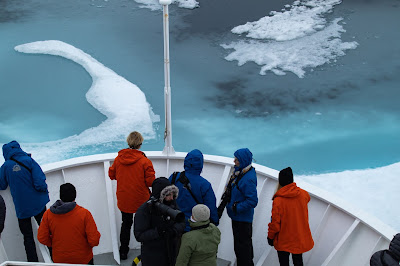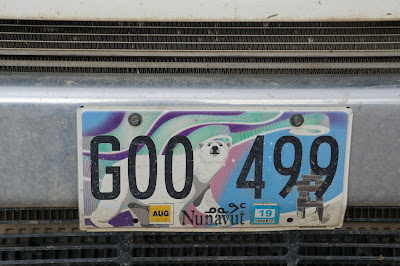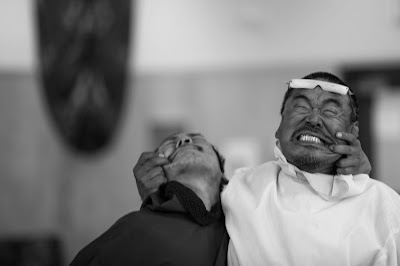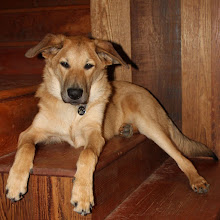During the night we sailed past Bylot Island and then turned west into Lancaster Sound toward the south western shores of Davon Island in search of the ice pack blocking the fabled Northwest passage.
The aft deck definitely was not a breakfast spot. I took my hot coffee and warm croissant to the bridge to watch the sea and radar for ice.
As we sailed, the morning presentation was on "Cetaceans of the Arctic" was given by our ever enthusiastic Whale biologist Connor. Not interested in the next scheduled presentation, I went up to my "Happy Place" the Library. The Library is part of the observation deck at the top of the ship and has banks of windows, leather chairs, hundreds of books and quick access to the open deck above the bridge. Throughout the voyage only a handful of us occupied this space. We were likeminded, quiet and hauled around large cameras and laptops for editing photos. The crew quickly realized that I enjoyed lunch in the library. Lunch was served more formally on the observation deck but after a couple days, I always found a table set for me in the library complete with place setting, hot roll and butter, a bowl of the soup of the day and my glass of ice water. All I needed to do was go into the dining area and grab my salad, entree and desert. Life was Very Good in the Library.
The presentation after lunch was "Seeing Artic Wildlife Before Seeing It". Serguei Ponomerenko barely got a word out when the call of "Bear!" came from the helm.
We had hit the pack ice and hunting bears were spotted. There is a bear in this picture somewhere. Or at least that is what I was told when I took it.
We had learned by this time to always be prepared with coats, hats, cameras and binoculars no matter what we were doing on the ship. He is out there.
This is my "Where's Waldo Bear" photo. He is there.
By now we all had a clear view.
Not knowing how long we would see him and this being the first polar bear of the trip, I took a LOT of pictures.
He chose to approach the ship.
Looking down on those on the forward deck and the bear. At this point there was total silence in the ship. We were so in awe and didn't want to scare him away.
He kept coming towards us.
It became evident he was going to jump this open lead. A hundred or so cameras were poised to catch him in flight. My camera wasn't fast enough to get more than the start of the lead. Others got some amazing in-air shots.
He landed and kept coming.
I don't know if you can get too many pictures of a polar bear. I do know it is nearly impossible to eliminate ones you have taken let alone decide on the best ones to post.
My travel-mates are probably facing the same dilemma.
He was so curious and just hung around the bow of the boat for over 1/2 hour.
His tongue thrust and yawning behaviors were similar to what I see in dogs approaching an unknown, possible threat.
Right below the bow on the ship.
He actually did disappear from our top-deck view as he got within feet of the hull. Then he decided we weren't anything to eat or maybe he just satisfied his curiosity. He ambled off from where he came.
Though occasionally looked back.
Then he settled in to watch us.
About that time three more bears were spotted. The ship maneuvered so we could get a better look. This is my "where's Waldo Mom Bear and Two Cubs" shot. They actually are in this picture but never approached the ship.
The edge of the ice pack.
We backed out and sailed away.
We never did get the "Seeing Arctic Wildlife" presentation but after tea, Matthias Breiter, the National Geographic bear guy, researcher and photographer, was scheduled to present a talk on "Polar Bear Biology". The session turned into answering questions about the bears we had seen and am impromptu slide show of some of the pictures taken earlier. Biology would have to wait.
You could tell we were getting further north. Sunset was at 2234.











































































.jpg)



